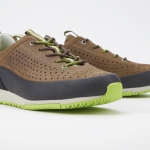Samantha Gottlich : “I’d like to know what inspired you to go into fashion. What do you like about fashion and what is your approach? “
Michel Abraham: My great grandfather was a taylor in Poland, my grand father owned a garment factory in France and my father was the CEO of a fashion group in Venezuela. I have spent a good chunk of my childhood running between tubular knitting machines and jumping around in printing facilities. I recall the very particular sound that fills a factory hallway when hundred of people are sewing at the same time.
But as a teenager, in the eighties, none of this interested me. All I wanted was to paint my name on trains and walls with spray cans, the way kids did in New York City. So that’s what I did. A lot.
There is a big part of secrecy involved in the life of a “graffiti writer”. If you want to stay out of trouble, you’d better keep your artistic activities well hidden. As a beginner in this scene, I didn’t know anyone. How could I meet my peers, and learn from them, paint with them, become one of them, if they all were hiding it? That’s when I learned, early on, the importance of fashion in human society.
After I met a couple of writers through acquaintances, I soon realised that they wore the same type of backpack, that they wore it a certain way, that a lot of them wore sneakers, mostly
Adidas Superstars,
Ewing 33 Hi or
Fila T1’s in Suede. And the more writers I met, the more details I noticed. There was a hidden message in the way they dressed, it was a way to show you belonged to the group, that you knew “what’s up”. It takes one to see one kind of thing.
So it seemed that every piece of garment we wore, beside its functionality (hooded sweatshirts to hide your face, sneakers to run away, backpacks to transport the paint ), also conveyed identity. We identified to a group, and sent a signal to our peers: “I am one of yours”. As I looked around the school halls, I saw it everywhere, it applied to every subculture not only writers. Teenagers gathered by “tribe”, each of these tribes associated to a certain type of music, behaved and dressed accordingly. There were skaters, punks, skinheads, goths, b-boys, teddy boys, metal heads etc… Even teachers used certain codes, and dressed a certain way. I started seeing patterns in the way my friend’s parents dressed, and adults in general.
Everybody wore a disguise! It was a revelation for a 14 years old. I was blown away.
In the mid 90’s as streetwear brands flourished, there was a lot of opportunities for someone like me, to enter the scene. I dressed like that for ever, I understood the codes and nuances of subcultures, Hip Hop in particular. Also I had painted so many murals and inked so many sketch books, that in my twenties, I already was a veteran in the field of graphic design. This experience, and the capacity I had to create graphics that were culturally and visually relevant to those brands, opened me the pathway to fashion design.

Michel Abraham Hong Kong office 2004
As I started working for apparel brands, I realised how much I knew about garment, fabrics, and the production process.
I remembered from my childhood, things my father used to say, that one should avoid cotton and synthetic fabrics on the same garment, that one should always use the best quality sewing yarn…
And progressively, from job to job, I went from graphic design to fashion design, to become head designer and brand director. I was lucky to meet incredible people along the way that helped me, inspired me, and taught me a lot.
You are the sum of all your experiences, that’s why my point of view on fashion, just like anybody else’s is very personal.
I still see fashion as a cultural and identity statement, and am very sensitive to beauty and elegance. I think fashion makes people happy, and helps them get rid of their insecurities, and therefore, I feel lucky to be part of the game.
It’s a tough game. The most difficult part of our job is to anticipate, a year in advance, what people will want to wear. You have to know what they want before they even know it exists, travel a lot, and recognise trends as they emerge, see a lot of different brands, a lot of different clothes.
When I see a piece of garment, I can’t help but turn it inside out, to check if the stitching has been properly done. I can’t help but notice that the shape of the pocket comes from an army jacket from the sixties, and to imagine the designers research and creative process. I can’t help but calculate how much the factory could have charged, how well the piece fits with the rest of the line, and whether or not it has been enzyme washed. I guess that when you are very exposed to something, it looses a bit of its mystic.
I am an insider. Many people like me are involved in the creation of a piece of garment, and in the process there also are people sitting behind a sewing machine on the other side of the planet, designers trying to reinvent the wheel, and merchandisers working 13 hours a day to make sure you can afford that cute red dress. There is so much more than what meets the eye…











